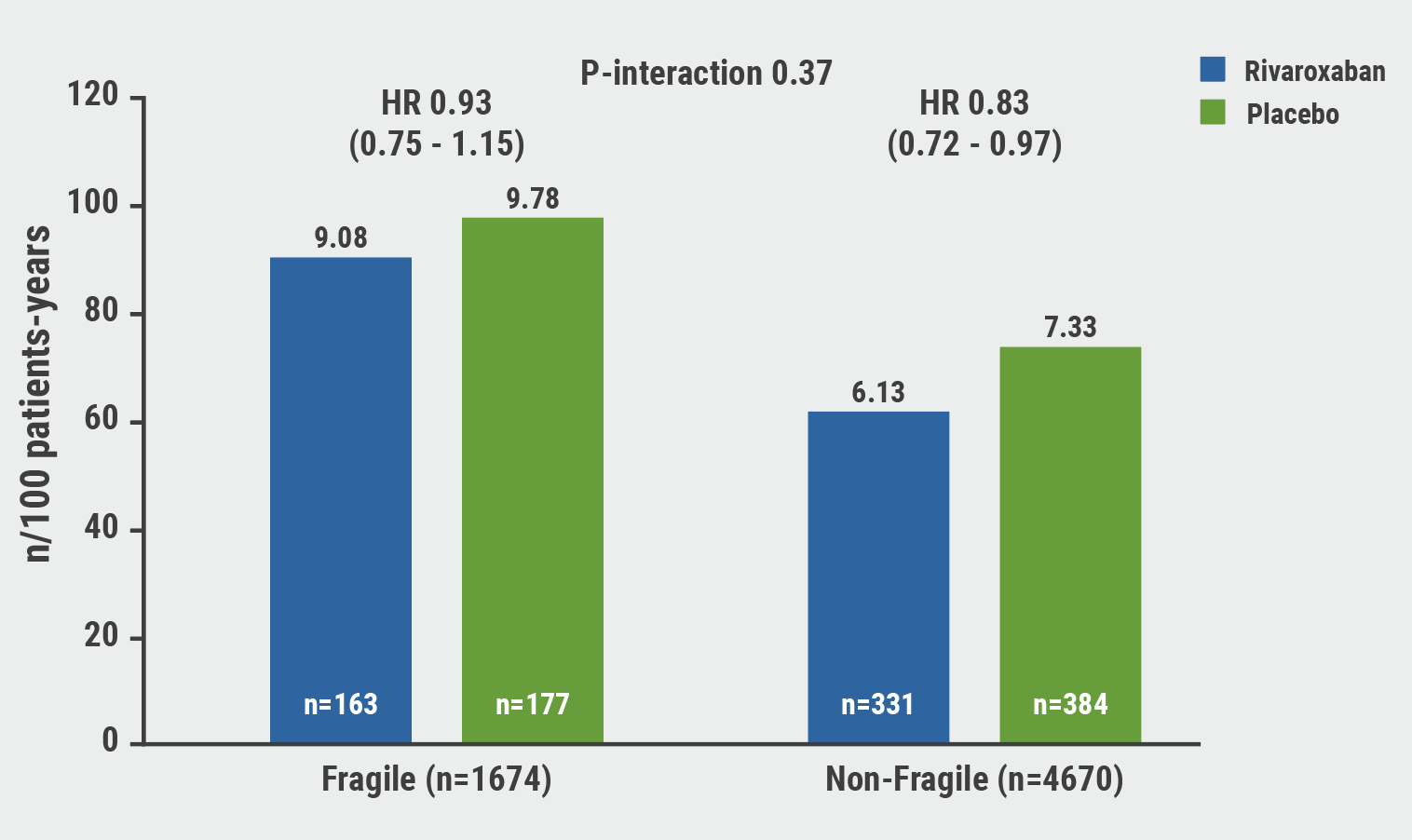Two pre-specified analyses of the VOYAGER PAD study in special populations showed that treatment benefit was evident in all subgroups with low-dose rivaroxaban in patients with symptomatic peripheral artery disease (PAD) who had just undergone peripheral artery revascularisation [1,2]. Both patients with diabetes and fragile patients gain a net benefit from treatment.
VOYAGER PAD (NCT02504216) included nearly 6,600 patients with symptomatic PAD who underwent peripheral artery revascularisation and demonstrated that the combined antithrombotic regimen of rivaroxaban plus aspirin was safe and effective for reducing the composite endpoint of acute limb ischaemia, major amputation of a vascular cause, myocardial infarction, ischaemic stroke, and cardiovascular death in this patient population with an absolute risk reduction of 2.6%. To assess whether this treatment benefit extends to subpopulations, 2 pre-specified analyses were performed in patients with diabetes and fragile patients. Both analyses were presented by Prof. Cecilia Low Wang (University of Colorado, CA, USA).
Participants with diabetes at baseline had a different baseline risk with more hypertension, coronary artery disease, a worse kidney function and more clopidogrel use compared with non-diabetics. “We found that among the placebo group the Kaplan Mayer estimate of the primary outcome at 3 years was 22.5% in those with diabetes and 18.2% in non-diabetes,” Prof. Low Wang said. There was also a dramatic difference between diabetics and non-diabetic patients in all-cause mortality: 12.9% of patients with diabetes compared with 9.6% of patients without diabetes randomised to placebo died within 3 years. The hazard ratio for the primary endpoint in patients with diabetes was 0.94, which was consistent with the overall population. The P-value of interaction for diabetes was not significant (0.16). “This analysis shows that the efficacy of rivaroxaban was consistent regardless of diabetes status at baseline,” Prof. Low Wang explained.
Prof. Low Wang also presented a pre-specified analysis of fragile patients, defined as age >75 years, weight ≤50 kg, and/or baseline eGFR <50 ml/min. Of the VOYAGER PAD participants, 26% were fragile according to this definition. Compared to the other participants, they were less frequently treated surgically.
A higher percentage of fragile patients reached the primary endpoint compared with the non-fragile group. However, similar to the participants with diabetes, the benefit was the same regardless of fragile status (see Figure).
Figure: VOYAGER PAD primary endpoint by fragile status [2]
Higher risk of TIMI major bleedings
A higher rate of discontinuation was observed in the diabetes population, which may have attenuated the observed benefit in the intention-to-treat analysis. However, the risk of TIMI major bleeding was significantly greater in patients with diabetes, possibly driven by the different baseline risk associated with bleeding. A higher percentage of patients with diabetes had a high bleeding risk at baseline compared with non-diabetics. As Prof. Low Wang emphasised, one should be aware that there were very few events of major bleedings overall. No major differences were seen in intracranial or fatal bleeding between the groups.
Similarly, fragile patients had a higher rate of ischaemic events and TIMI major bleedings, but there was no difference in intracranial or fatal bleeding. Overall, there was still a 6:1 benefit-risk ratio.
Although both diabetes and fragility are associated with a higher percentage of patients achieving the primary outcome and higher bleeding risk, therapy with rivaroxaban should be considered in these subgroups because its efficacy and safety of rivaroxaban are consistent regardless of these factors.
- Low Wang C. VOYAGER PAD – rivaroxaban in symptomatic PAD with and without comorbid diabetes. Latest science in special populations, ESC Congress 2021, 27–30 August.
- Low Wang C. Risk profile and the efficacy and safety of rivaroxaban in fragile PAD patients after revascularisation: Insights from VOYAGER PAD. Latest science in special populations, ESC Congress 2021, 27–30 August.
Copyright ©2021 Medicom Medical Publishers
Posted on
« NATURE-PCSK9: Vaccine-like strategy successful in lowering CV events Next Article
Long COVID symptoms – Is ongoing cardiac damage the culprit? »
Table of Contents: ESC 2021
Featured articles
2021 ESC Clinical Practice Guidelines
2021 ESC Guidelines on Heart Failure
2021 ESC/EACTS Guidelines on Valvular Heart Disease
2021 ESC Guidelines on Cardiac Pacing and Cardiac Resynchronisation Therapy
2021 ESC Guidelines on Cardiovascular Disease Prevention
Best of the Hotline Sessions
Empagliflozin: First drug with clear benefit in HFpEF patients
CardioMEMS: neutral outcome but possible benefit prior to COVID-19
Cardiac arrest without ST-elevation: instant angiogram does not improve mortality
Older hypertensive patients benefit from intensive blood pressure control
Antagonising the mineralocorticoid receptor beneficial for patients with diabetes and CKD
Late-Breaking Science in Heart Failure
Valsartan seems to attenuate hypertrophic cardiomyopathy progression
Dapagliflozin reduces incidence of sudden death in HFrEF patients
Late-Breaking Science in Hypertension
Smartphone app improves BP control independent of age, sex, and BMI
QUARTET demonstrates that simplicity is key in BP control
Salt substitutes: a successful strategy to improve blood pressure
Late-Breaking Science in Prevention
NATURE-PCSK9: Vaccine-like strategy successful in lowering CV events
Polypill: A successful tool in primary prevention
Important Results in Special Populations
VOYAGER PAD: Fragile or diabetic patients also benefit from rivaroxaban
COVID-19 and the Heart
Rivaroxaban improves clinical outcomes in discharged COVID-19 patients
COVID-19: Thromboembolic risk reduction with therapeutic heparin dosing
Long COVID symptoms – Is ongoing cardiac damage the culprit?
ESC Spotlight of the Year 2021: Sudden Cardiac Death
Breathing problems: the most frequently reported symptom before cardiac arrest
Lay responders can improve survival in out-of-hospital cardiac arrest
Related Articles
Smartphone app improves BP control independent of age, sex, and BMI

© 2024 Medicom Medical Publishers. All rights reserved. Terms and Conditions | Privacy Policy
HEAD OFFICE
Laarderhoogtweg 25
1101 EB Amsterdam
The Netherlands
T: +31 85 4012 560
E: publishers@medicom-publishers.com

